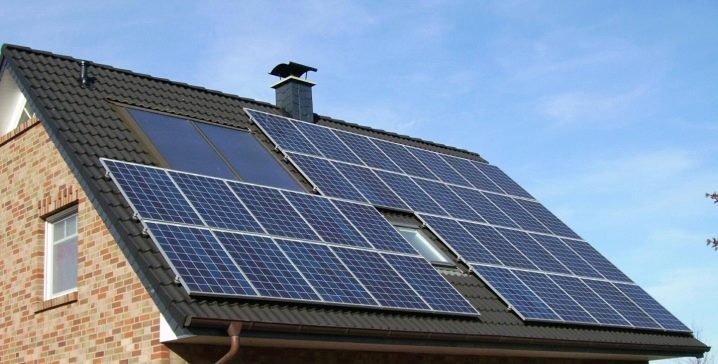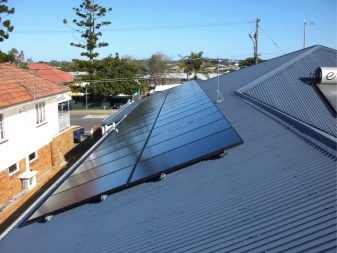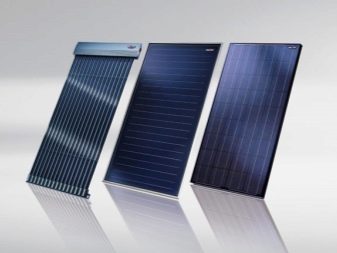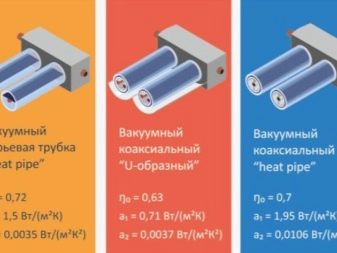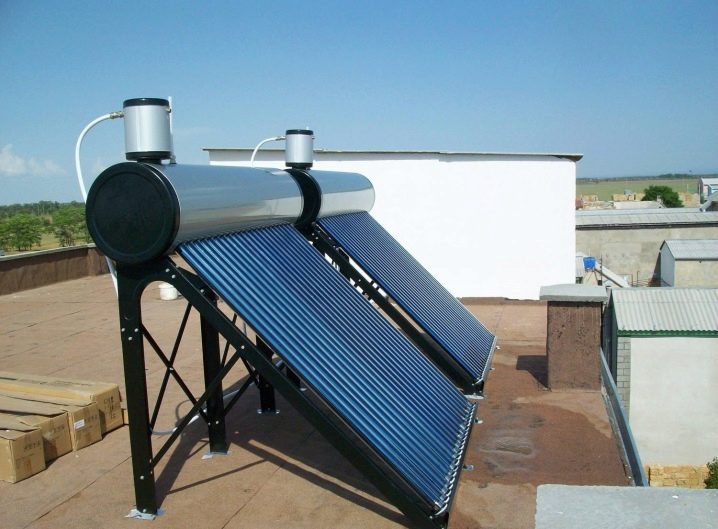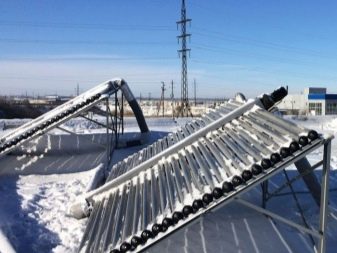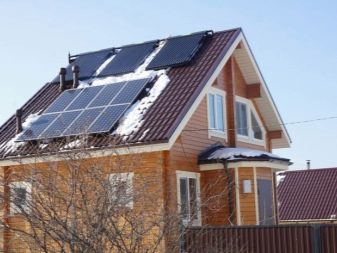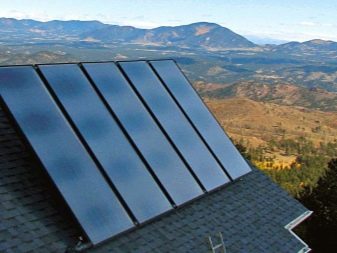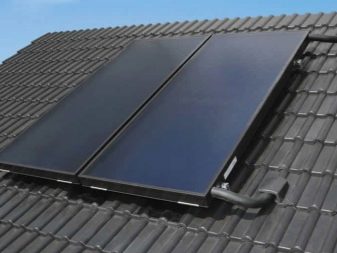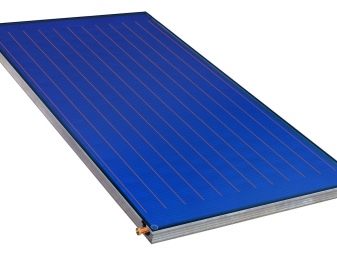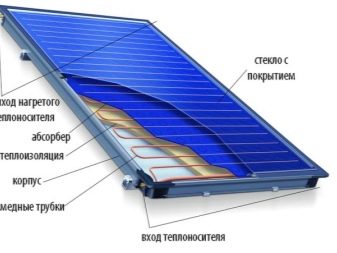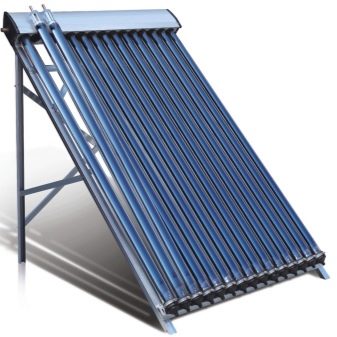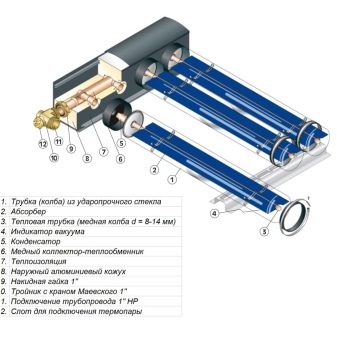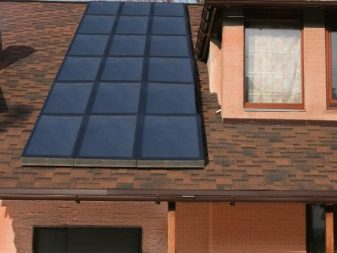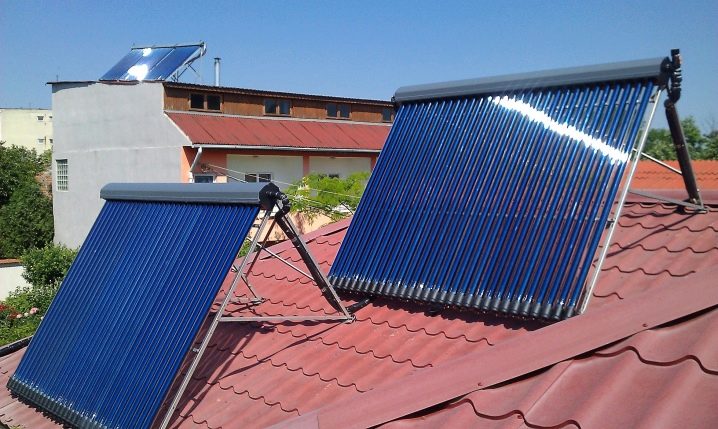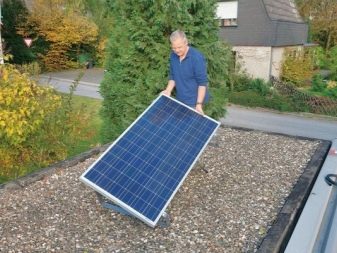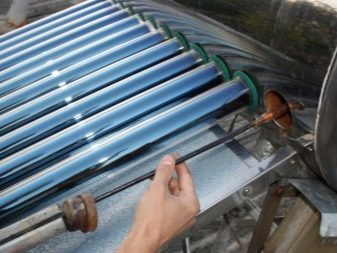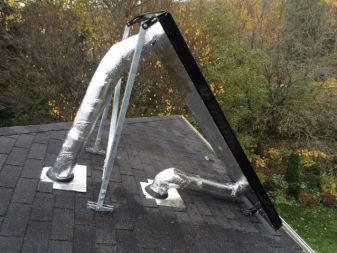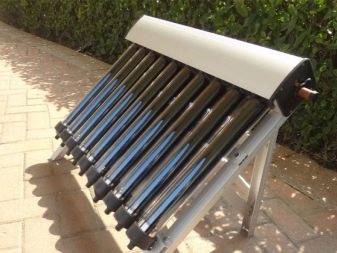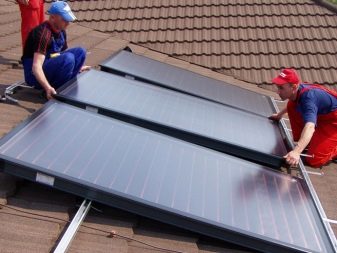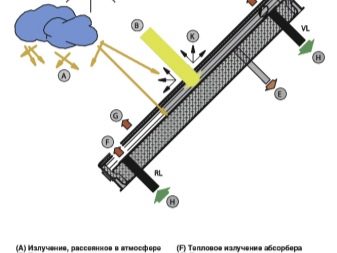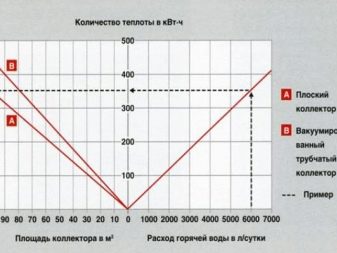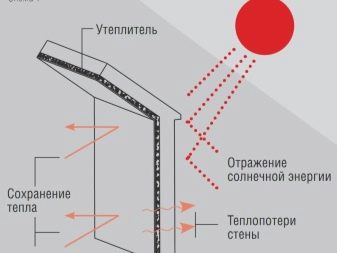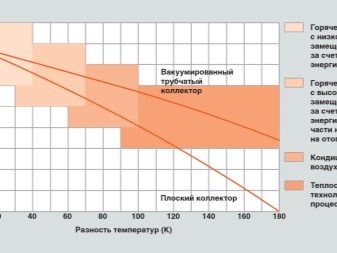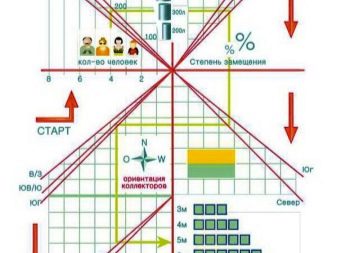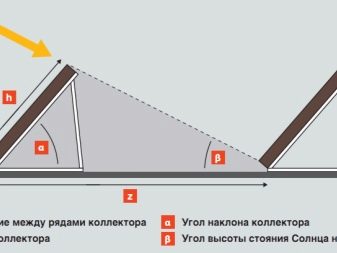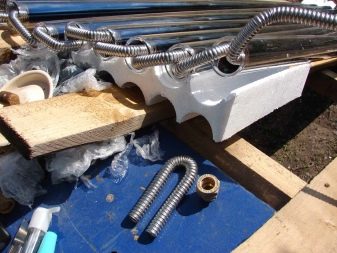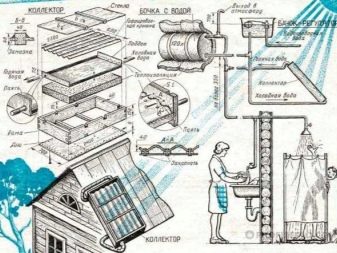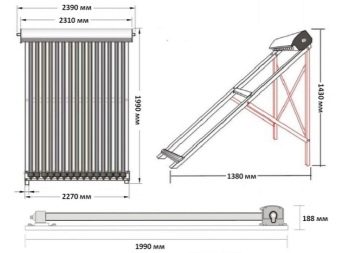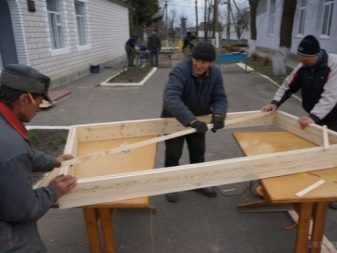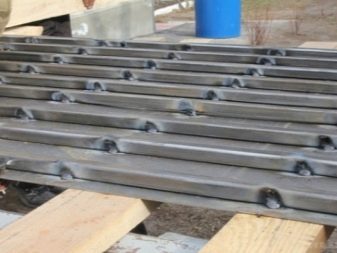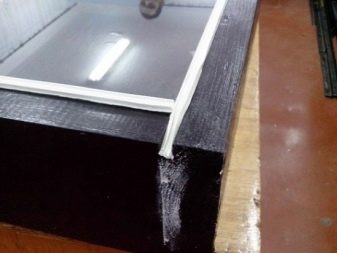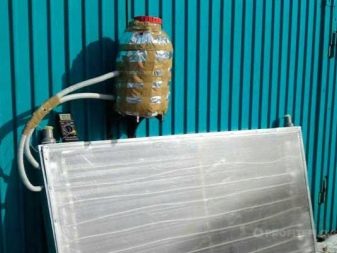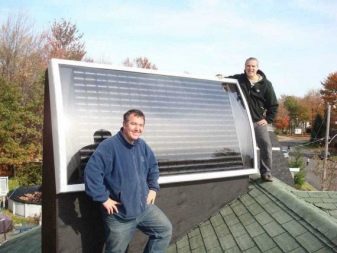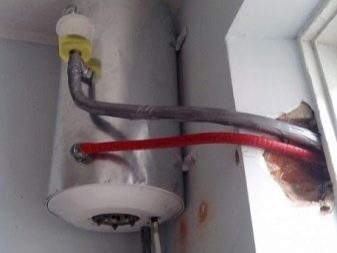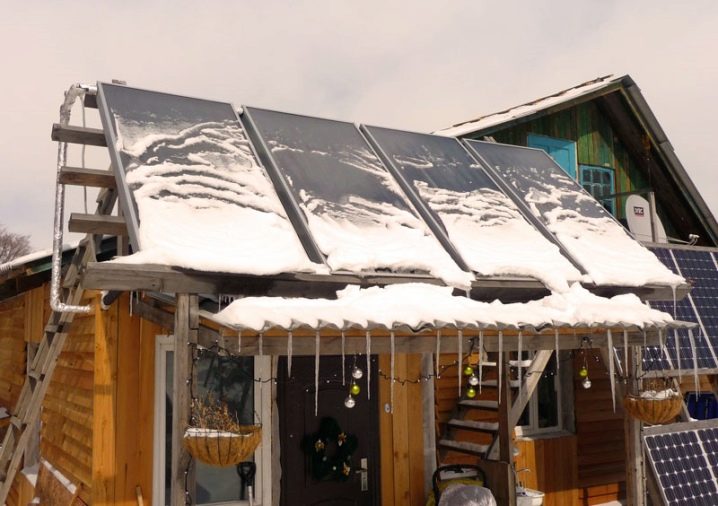Varieties and features of the installation of a solar collector for heating
Today there is an opportunity to reduce heating costs. All this is real thanks to solar collectors, which are unique systems that allow you to get an ecological source of clean energy for free. They can be actively used for heating small country houses and cottages.
Features and device
The solar collector is a modern design that is able to accumulate solar energy and turn it into a source of heat. The device is made of metal plates, painted black and enclosed in a glass case. Such equipment can be installed for home heating, as well as for providing systems with hot water.
Thanks to the installation of the collector, you can save from 30 to 60% of energy, and this means that the cost of electricity and gas is significantly reduced and the maintenance of the house is cheaper. A device connected to the heat supply system plays the role of a heat carrier that maintains the temperature around the clock in accordance with sanitary and technological standards.
The design of the solar collector is presented in the form of a system of tubes connected in series with each other and having an input and output main. Through the tubes can pass as the air flow, and process water. During the circulation of a substance, its transition from one state of aggregation to another is observed, as a result of which heat is generated. That is, the principle of the battery is in the accumulation of energy by photocells, its concentration and transmission.
In addition to tubes, the design also has a special tank where water is stored in a heated state. So that the liquid does not cool, the tank is additionally sheathed with high-quality thermal insulation. In addition, a backup electric heater is installed in the tank, which is automatically switched on in winter or in case of cloudy weather.The collector body, as a rule, is made of glass, since the use of polymeric materials is not recommended. They have a high rate of thermal expansion, are unstable to ultraviolet rays, which can lead to depressurization of the body.
Water is usually chosen as the coolant, but if it is planned to operate the system year-round, then it is necessary to replace the technical liquid with antifreeze before the onset of cold weather. Often the air also acts as a coolant in the collectors, and channels for moving it are made of professional sheets.
For heating small buildings, conventional structures are used; for autonomous and centralized systems, not only heating equipment but also circulation pumps are added to the circuit.
The main advantages of solar units include:
- possibility of uninterrupted heating of buildings all year round;
- long service life reaching 30 years;
- energy savings;
- possibility of simultaneous heating of premises, greenhouses, extensions and pools;
- no waste;
- quick installation;
- optimization for individual projects.
As for the shortcomings, they are few:
- high installation cost;
- low efficiency of the device due to climatic conditions and landscape features;
- forced circulation of water.
Kinds
There are many types of solar collectors, all of them differ in the design features, but equally play the role of heat carrier and are used to heat homes. Today, the following types of devices are distinguished:
Flat
It is considered the most common option for installation in modern solar energy systems. It consists of an absorber, a thermally insulating coating, a transparent layer and a heat carrying tube. The popularity of this type is due to ease of installation and affordable price, but unlike other collectors it is characterized by a small efficiency. Externally, the device has the appearance of a steel or aluminum panel with an area from 2 to 2.5 m2.
Outside the panel is covered with sheets of helioglassThis allows you to maximize the energy of the sun and supply it with minimal losses. Under the glass is a special absorber in the form of a flat tube, it is made from aluminum or copper alloys.The tube is equipped with radial fins, therefore during the working process there is a high efficiency.
Flat collector is only suitable for heating a private house, as with its help in winter you can heat a small area.
Vacuum
This is an expensive device that has excellent performance. The battery is a series consisting of paired glass tubes. Air is pumped out from the space between them and the soldering is performed; the vacuum thus formed serves as a good heat insulator and reduces energy losses. The upper tubes are inserted into the distributor, where the coolant itself circulates. Depending on the distribution of heat such collectors are straight-through and with a flat tube.
Air
This device is intended for heating buildings by heating air masses. The air flows into the system through the absorber and is delivered naturally or forcibly supplied to the heat exchanger. The disadvantage of the collector is that, unlike liquid species, heat is not so good in it. But such a system is characterized by a simple design and is easily managed.If you follow all the rules of operation, the collector will serve more than 20 years.
Water
Externally, it resembles a vacuum device, but in its construction a liquid is located in the tubes at a certain angle. The tubes are connected to a tank, from which hot water is transferred to the system and returned. The main advantage of the unit is that its installation does not require the use of additional elements. Some models of such collectors can also work without a tank. During operation of the water collector at a temperature below -10 ° C, it is necessary to fill in the non-freezing liquid.
How to choose?
Before you install the solar collector, you need to choose the appropriate type of device, as this will depend on the efficiency of its work and the heat transfer coefficient.
Therefore, going shopping, it is worth considering the following nuances:
- It is best to give preference to flat models, as they are considered the most durable and have positive consumer feedback. Their unit is able to heat water above 40 ° C, but if the battery fails, you will have to replace the entire adsorption system.Vacuum types of devices are characterized by rapid damage to the tubes and are very sensitive to external influences. But it is worth noting that the repair of the product is simple, since only a specific flask is replaced. But in winter, such batteries maintain the temperature well, which is their plus.
- As for air collectors, they rarely fail and do not require repair. In addition, they reliably withstand low temperatures and are durable to use. The only thing that such devices are not suitable for heating large buildings, as the rooms warm up poorly.
- An important indicator for selection is the size of the tubes, which determines the efficiency of conversion of solar energy. Small-diameter tube reduces energy production. Therefore, it is desirable to purchase collectors that have several large flasks in the construction with a width of up to 6 cm and a length of up to 2 m.
- Special attention should be paid to battery power. Systems with low heat retention cannot be used at low temperatures. In particular, this applies to models with water heat supply.
- Installation of the installation must be carried out after preliminary design. To do this, you need to know the size of the battery, which would be suitable for mounting to the roof.
- It is possible to buy collectors both with a vertical, and horizontal arrangement. At the same time, vertical structures should be issued from problems with snow removal, but their efficiency will be low. To avoid this, it is necessary to provide a place for the outcome of precipitation before installation.
Payment
Solar energy is the ideal source for heating buildings. In order to maximize its transformation into heat, it is necessary to accurately calculate the cost of resources and power of the installations, taking into account the type of unit and its location. First of all, you need to know how much energy gets to the surface of the panel. As is known, about 1367 W of solar energy per 1 m2 of surface, but passing through the layers of the atmosphere, power is lost up to 500 W. In this regard, for average calculations, a conventional value of 800 W is taken.
The solar collector is a work station, the base of which is protected by anti-reflective coating and glass. Due to the fact that the base is covered with black paint, there is a 100% absorption of energy.Since the battery contains heat insulation, it is possible to determine the coefficient of heat loss. It is different for each material, but the insulation of the collectors is often performed on the basis of mineral wool, therefore, for simple calculations, the index 0.045 is taken. Assuming that the temperature difference between the outer and the inner layer of thermal insulation does not exceed 50 C, the energy loss will be: 0.045: 0.1 × 50 = 22.5 W.
The losses for pipes will be similar, so the total figure will be 45 watts. Therefore, to heat 1 liter of water at 1 C, an energy of 1.16 W is required. Having determined these values, one can easily find out the volume of liquid that can be heated by a battery with a working area of 1 m2 per hour: 800: 1.16 = 689.65. To improve heat transfer, units are best placed with a south orientation.
An important calculation is considered, and the working area of the battery. To do this, the amount of required energy must be divided by 800 W and the desired value will be obtained. But you should pay attention that this indicator corresponds to the area of the unit, designed for servicing one person. Therefore, if a family of two, three or more people lives in the house, the value should be increased.
Manufacturing
You can not only install the solar unit yourself, but also make it yourself.The self-made collector can be both vacuum, and air or flat.
What to install the device will need the following elements:
- temperature sensors;
- adapters leading to the system of connecting cold and hot water;
- drain for hot water;
- solar energy regulator;
- tank or tank;
- circulation pump;
- sensors control the heating of water.
Connection and assembly of all components of the structure should be carried out according to the project, adhering to the instructions:
- At the first stage, the dimensions of the future collector are determined. To do this, accurately calculate the area of its placement and the intensity of solar energy. It is important to pay attention to the location of the building where the installation of the system is planned, depending on the indicators obtained, the material for the heating circuit is selected.
- The next step is to assemble the device, during which the box, radiator, storage tank and heat exchanger are made. The box can be made of edged boards not less than 5 mm thick, its bottom is covered with a galvanized sheet and an additional styrofoam is laid, which will serve as good thermal insulation.For the heat exchanger, tubes with a length of 1.6 m are used, they must be 15 pieces, they are assembled into a one-piece construction, observing a 4.5 cm pitch. To improve the absorption of the rays, the bottom of the box is painted in a dark color, then glass and joints are installed sealed.
As the main accumulator it is possible to use both a vessel with a volume from 140 to 380 l, as well as other welded structures or barrels. The container must be well insulated from heat loss, therefore, the anankamera is additionally equipped with a hinged crane. First, an avant-chamber and heat store are mounted, then the resulting structure is placed at an angle of 35–40.
A distance of 70 cm is made between the accumulator and the heat exchanger, otherwise the loss of thermal energy will be significant.
- The final stage is the commissioning of equipment. The resulting structure is attached to the water supply. Valves are required for this. The device is filled with water and attached avankera. Then it is important to check the fluid level and the absence of water leaks. After control, the homemade collector is ready for operation.
Tips
Installing solar systems saves energy by providing the house with “free” heat and hot water.But choosing this type of device, you need to remember that the efficiency of the system will decrease significantly in the evening and in the morning, since the main volume of energy is produced in bright sun. So that solar collectors will reliably serve for many years and smoothly provide the building with heat, When choosing and installing them, the following recommendations of specialists should be taken into account:
- When buying a battery, you should clarify whether it is possible to operate it in the winter and how much power the system has.
- If the collector is assembled on its own, the lower part of its heat exchanger should be provided with monetary valves and thermal insulation, which will allow to maintain the quality of the heated fluid. In this case, the pipes can also be wrapped with a thick cloth or polyethylene.
- A valve must be present in the structure to prevent circulation from the coolant. If there is a sharp decrease in temperature, then the valve must be closed.
- Before you build solar installations, you should make a detailed calculation of the area of the batteries, as well as the maximum energy production.
How to make a solar collector with your own hands from aluminum cans, see the next video.
